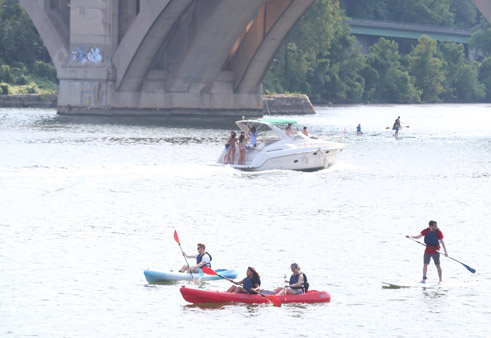Park Service Releases Boathouse Sites Study

By Mark LiebermanCurrent Staff Writer
The National Park Service has narrowed its proposed options for new Georgetown boathouses, with only one development scenario remaining under consideration for the 1,500-foot stretch of riverfront from 34th Street NW to west of the Key Bridge.
In an environmental assessment released Thursday, the Park Service studied a proposal for two or three new boathouses and other improvements, as well as an option that would make no change to the status quo.
The new study is the latest step in an effort spanning nearly 30 years to increase the area’s existing boathouse capacity, which is used by Georgetown and George Washington universities, as well as high school crew teams and members of the public. “This is the final public comment period, so barring something unforeseen it is unlikely anything that hasn’t been addressed over the many years this planning effort has been in progress would be considered or proposed,” Park Service spokesperson Jenny Anzelmo-Sarles wrote in an email yesterday.
Under the development scenario, one 13,800-square-foot boathouse would be situated on a sizable vacant lot between the Key Bridge and the Georgetown Waterfront Park. A second 3,600- to 4,200-square-foot boathouse would be constructed just east of the Potomac Boat Club, as well as a 6,000-square-foot storage facility for canoes and kayaks between the Potomac Boat Club and the Washington Canoe Club. The plan also allows for the possibility of a small boathouse west of the Washington Canoe Club. Under this action alternative, the Washington Canoe Club building would receive a complete restoration, and other smaller improvements would address traffic flow and pedestrian safety in the area.
The current proposal retains the two Key Bridge boathouses that were constants among three alternatives first shown in 2015 and hews closest to last year’s proposed “low-density” option, with the exception of the new plan’s possible third boathouse west of the Washington Canoe Club.
Abandoned concepts from the higher-density options include a 10,000-square-foot boathouse between the Washington Canoe Club and the Potomac Boat Club, and a storage facility just east of the latter. The original size of the proposed boathouse next to the Potomac Boat Club has shrunk in size from 7,800 square feet in the 2015 plan to between 3,600 and 4,200 square feet in the new one.
In developing this final plan for each of the affected sites, the National Park Service factored in ease of access to transportation, as well as its goals of diversifying visitor activities along the riverfront and efficiently spreading out access to water resources. The 10,000-square-foot structure proposed earlier “would not fit onto the site very well,” the study concludes. Other modifications reflect an effort to preserve the aesthetics of the area and its surrounding historic district while enhancing accessibility to the site and establishing accessible connections between the boathouse sites.
The project’s overall purpose, according to the Park Service, would be to add more opportunities for non-motorized boats to exit and enter the river near Georgetown, providing more access points for the expanding culture of water sports in the area. The study states that the existing boathouse facilities are insufficient and that the current configuration leads to frequent conflicts between pedestrians and cyclists.
Although the study has been long in the works, the plans themselves remain in the early stages and could change before construction begins, assuming the Park Service moves forward with the action alternative. In-progress projects — like the condominium development at 34th and Water streets NW, the planned conversion of the West Heating Plant into residences, and C&O Canal trail improvements — could impact future plans, the study states. Meanwhile, the study notes that a group of town houses adjacent to the site of the planned smaller boathouse could become available, in which case that boathouse could as much as double in size.
Early reactions to the new boathouse plan — totaling nearly 200 pages of text — have been mixed.
Rod Mackler, first vice president of the C&O Canal Association, told The Current he’s pleased with this latest iteration of the plans, especially in comparison to earlier ideas that his team felt were less feasible.
The association’s priorities, according to Mackler, include maximizing public access; constructing reasonably sized facilities that don’t dwarf the canal towpath; and situating the largest buildings below the remains of the Alexandria Aqueduct just north of the Key Bridge. This plan does all three, Mackler said.
“My general feeling is that it’s a very fair-minded document. It looks pretty good,” he said. “It responds to a lot of the concerns that we as an organization and individuals have expressed over the 30 years of this project.”
Mackler said he’s particularly happy to see that the largest boathouse will take up the empty waterfront lot, which he notes is covered in weeds and paved over with asphalt. “A boathouse would certainly seem to be an improvement on the status quo of that site,” Mackler said.
Concerns about the exact shape and size of the building remain, Mackler said. His colleagues are particularly focused on ensuring that any construction preserves the “rural” appearance of the canal park looking west from the waterfront park. Overall, the plans strike him as far more sensible than previous designs, which allowed for more and larger buildings, he said.
The plans aren’t without their detractors, though. Citizens Association of Georgetown president Bob vom Eigen told The Current he’s concerned that the emphasis on facilities for kayaks and canoes will leave the rowing teams at George Washington and Georgetown universities competing for space with high school teams and the public, as they do now.
“It’s really disappointing,” vom Eigen said in an interview. “It just doesn’t sound practical to me.”
Georgetown University’s Ryan King wrote in an email that the school is “monitoring the situation closely.”
“We are hopeful the EA lays out a path forward for Georgetown to partner with the Park Service to build a university boathouse that will better serve the needs of Georgetown and the community,” King wrote.
Representatives from George Washington University didn’t respond to requests for comment in time for publication.
In the meantime, vom Eigen said he’ll be gathering interested parties for a meeting on the boathouse issue next month.
Georgetown advisory neighborhood commissioners and Georgetown Business Improvement District representatives told The Current they’re reviewing the boathouse study but haven’t come to a consensus yet.
Stakeholders have until Sept. 30 to submit comments on the plan at parkplanning.nps.gov/nmbzea. The agency will also accept written comments to Tammy Stidham, National Park Service — National Capital Region, 1100 Ohio Drive SW, Washington, DC 20242.
This article appears in the Aug. 3 issue of The Georgetown Current newspaper.





